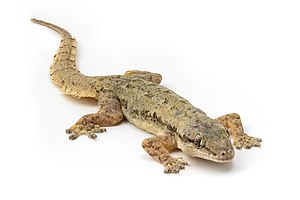Asiatic house gecko
| Asiatic house gecko | ||||||||||||
|---|---|---|---|---|---|---|---|---|---|---|---|---|

Asiatic house gecko ( Hemidactylus frenatus ) |
||||||||||||
| Systematics | ||||||||||||
|
||||||||||||
| Scientific name | ||||||||||||
| Hemidactylus frenatus | ||||||||||||
| Duméril & Bibron , 1836 |
The Asian house gecko ( Hemidactylus frenatus ), also known as the common half-finger , is a small type of gecko that originally only occurred in Southeast Asia, but was spread by humans on all tropical and subtropical continents and numerous islands.
distribution
In Asia, the range of the species extends from Pakistan in the west to Indonesia in the east and the Ryūkyū Islands in the north. In Africa, the species is found on the coasts of Djibouti , Somalia and Kenya, as well as on Madagascar , Mauritius , Réunion , Rodrigues , the Seychelles and on the Comoros island of Mayotte . In the New World, the common half-finger occurs from Mexico to Central America to Colombia and Ecuador, in Australia in the Northern Territory , in Queensland and Western Australia . Islands that the species has colonized are the Chagos Archipelago in the Indian Ocean, New Guinea , the Solomon Islands , the Carolines (including Pohnpei , Mortlock Islands , Chuuk ), Nauru , Vanuatu , Tonga , the Samoan Islands , New Caledonia , Fiji and the Cook Islands in Pacific.
features
The Asian house gecko reaches a head-to-trunk length of 6.5 and a maximum total length of 13.8 cm. The body is slim, the head clearly separated from the body. Due to the widespread distribution of the species, it is very variable in terms of color and scaling . The upper side is usually light or dark gray-brown, monochrome or darkly mottled or banded. The belly is whitish or yellowish, the underside of the tail occasionally reddish. There is a dark lateral stripe on the sides of the head. Young animals have the same coloration as adult animals, but their coloration is more contrasting. The animals have ten to twelve scales of the upper lip and seven to ten scales of the lower lip . The ear opening is small, oval in shape and sloping. Between the small back scales there are irregularly arranged keeled scales with tubercles . The ventral scales are arranged in 28 to 36 rows. They are smooth, rounded, and overlap.
Way of life
In Southeast Asia, Hemidactylus frenatus is a common house gecko, found in both villages and large cities. It is primarily active at night and at dusk and often seen in the vicinity of lighting systems at night to hunt the insects that gather there. The cheeky utterances, which is why it is also called "Tinktock" or "Tschicktschak", can often be heard during the day. The Asiatic house gecko can be found on or in buildings, on rocks, on trees, modern wood or under stones. The females lay two hard-shelled, almost round eggs that are 9 to 10 mm in diameter 4 to 6 times a year. The young animals have a head-trunk length of 18 to 22 mm and a total length of 36 to 44 mm when hatched.
literature
- Ulrich Manthey, Wolfgang Grossmann: Amphibians & Reptiles of Southeast Asia. Natur und Tier Verlag, Münster 1997, ISBN 978-3-931587-12-3 , pp. 235-237.
Web links
- Hemidactylus frenatus in The Reptile Database
- Hemidactylus frenatus in the endangered Red List species the IUCN 2010. Posted by: Ota, H. & Whitaker, AH, 2009. Retrieved on 8 November 2016th